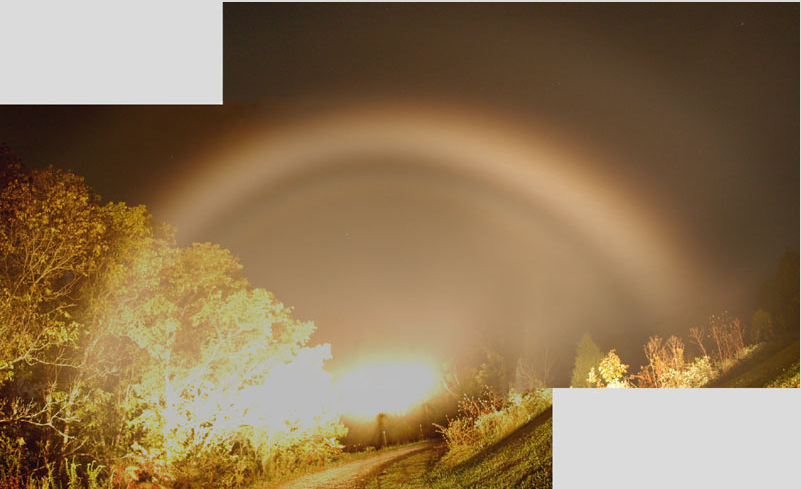Car headlight fogbow
Car Headlight Fogbow: A Phenomenon of Atmospheric Optics
Have you ever noticed a mesmerizing rainbow-like arc around car headlights on a foggy night? This enchanting phenomenon is known as a car headlight fogbow. Similar to a traditional rainbow, it is formed when light interacts with water droplets in the air. However, there are some distinct characteristics that set the car headlight fogbow apart. In this article, we will explore the science behind this captivating optical display and delve into its unique features.
How is a Car Headlight Fogbow Formed?
A car headlight fogbow is created when the light emitted from a vehicle's headlights encounters tiny water droplets suspended in the air. These droplets act as miniature prisms, bending and scattering the light. The formation process is similar to that of a traditional rainbow, where sunlight interacts with raindrops. However, there are a few factors that differentiate the car headlight fogbow from its natural counterpart.
The Distinctive Features of a Car Headlight Fogbow
-
Colors and Intensity: Unlike a traditional rainbow, which exhibits a wide range of vibrant colors, the car headlight fogbow often appears as a faint white or grayish arc. This subdued color palette is due to the smaller size of the water droplets in fog compared to raindrops.
-
Outer Fringe: One distinguishing feature of the car headlight fogbow is its outer fringe, which is often tinged with red. This reddish hue occurs because the light undergoes a process called diffraction, causing longer wavelengths (such as red) to bend more than shorter wavelengths (such as blue).
-
Supernumerary Bands: Inside the main fogbow, you may notice well-defined bands of colors that appear as alternating shades of blue and red. These bands, known as supernumerary bands, result from interference between light waves that have been diffracted by the water droplets. The colors in the supernumerary bands are reversed compared to those in the outer fringe.
-
Secondary Fogbow: If you direct your gaze outside the main fogbow, you might spot a faint secondary fogbow. This secondary arc is formed by two internal reflections inside the water droplets. It is often less visible than the primary fogbow but can still add to the enchantment of the overall spectacle.
Exploring the Science Behind Car Headlight Fogbows
To fully understand the science behind car headlight fogbows, it is essential to delve into the properties of light and the behavior of water droplets in the atmosphere. Here are some key factors at play:
-
Light Dispersion: When light encounters a water droplet, it undergoes refraction, causing it to change direction. Additionally, different wavelengths of light are refracted by varying amounts, resulting in the separation of colors.
-
Diffraction: As light passes through the tiny water droplets, it also undergoes diffraction. This phenomenon causes the light to spread out and form distinct fringes of color.
-
Interference: Interference occurs when multiple light waves overlap and either reinforce or cancel each other out. In the case of car headlight fogbows, interference between diffracted light waves gives rise to the supernumerary bands.
-
Droplet Size Distribution: The size distribution of water droplets in fog plays a crucial role in determining the appearance of a car headlight fogbow. Smaller droplets tend to produce more pronounced diffraction and interference effects, resulting in clearer supernumerary bands.
Capturing the Beauty of Car Headlight Fogbows
Witnessing a car headlight fogbow can be a rare and captivating experience. To enhance your chances of observing this optical wonder, keep the following tips in mind:
-
Choose a foggy night with suitable visibility conditions.
-
Position yourself at an appropriate distance from the car's headlights to observe the fogbow clearly.
-
Avoid excessive light pollution, as it can diminish the visibility of the fogbow.
-
Consider using a camera to capture the ethereal beauty of the car headlight fogbow. Experiment with different exposure settings to bring out the subtle colors and details.
In conclusion, the car headlight fogbow is a remarkable example of atmospheric optics. Its unique characteristics, such as the outer fringe, supernumerary bands, and secondary fogbow, make it a captivating sight to behold. By understanding the science behind this phenomenon and employing some practical tips, you can enhance your chances of experiencing and capturing the enchanting beauty of a car headlight fogbow.

Car headlight fogbow by Michael Ellestad (atmospheric optics site). The shadows of the camera and tripod are visible on the track. The camera shadow marks the centre of the bow. The main fogbow is fringed with red on the outside. Inside it a well defined supernumerary has reversed colours - blue outside and red inside. Look outside the main bow to see a faint secondary fogbow produced by two internal reflections inside the fog droplets. More car fogbows. ©2004 Michael Ellestad, shown with permission.
Note: this article has been automatically converted from the old site and may not appear as intended. You can find the original article here.
Reference Atmospheric Optics
If you use any of the definitions, information, or data presented on Atmospheric Optics, please copy the link or reference below to properly credit us as the reference source. Thank you!
-
<a href="https://atoptics.co.uk/blog/car-headlight-fogbow/">Car headlight fogbow</a>
-
"Car headlight fogbow". Atmospheric Optics. Accessed on November 26, 2024. https://atoptics.co.uk/blog/car-headlight-fogbow/.
-
"Car headlight fogbow". Atmospheric Optics, https://atoptics.co.uk/blog/car-headlight-fogbow/. Accessed 26 November, 2024
-
Car headlight fogbow. Atmospheric Optics. Retrieved from https://atoptics.co.uk/blog/car-headlight-fogbow/.